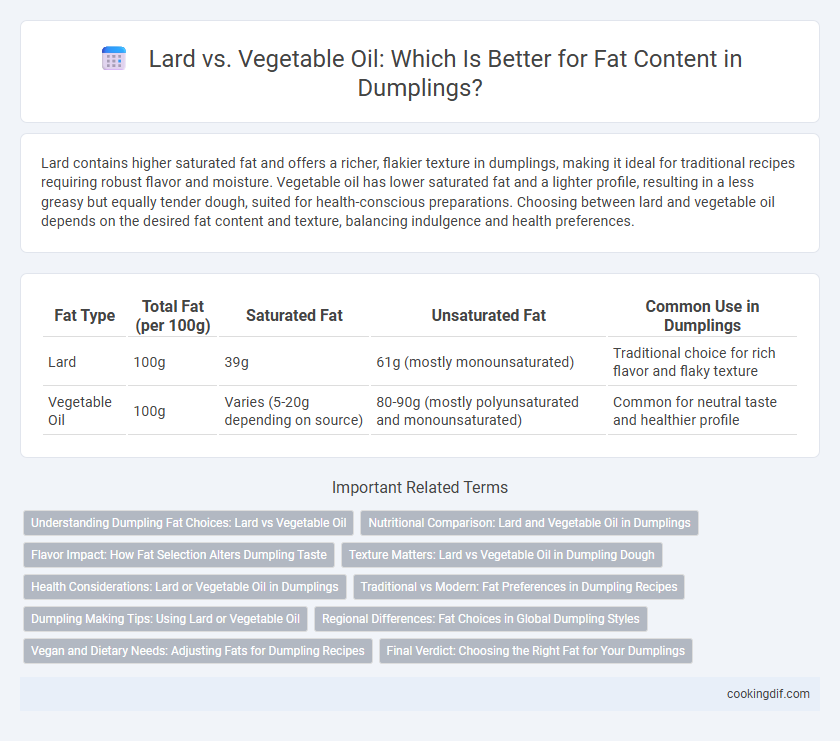Lard contains higher saturated fat and offers a richer, flakier texture in dumplings, making it ideal for traditional recipes requiring robust flavor and moisture. Vegetable oil has lower saturated fat and a lighter profile, resulting in a less greasy but equally tender dough, suited for health-conscious preparations. Choosing between lard and vegetable oil depends on the desired fat content and texture, balancing indulgence and health preferences.
Table of Comparison
| Fat Type | Total Fat (per 100g) | Saturated Fat | Unsaturated Fat | Common Use in Dumplings |
|---|---|---|---|---|
| Lard | 100g | 39g | 61g (mostly monounsaturated) | Traditional choice for rich flavor and flaky texture |
| Vegetable Oil | 100g | Varies (5-20g depending on source) | 80-90g (mostly polyunsaturated and monounsaturated) | Common for neutral taste and healthier profile |
Understanding Dumpling Fat Choices: Lard vs Vegetable Oil
Lard contains about 40-50% saturated fat and provides a rich, savory flavor that enhances dumpling texture and mouthfeel, while vegetable oil typically has higher unsaturated fats, promoting a lighter, less greasy result. The choice between lard and vegetable oil significantly affects dumpling dough elasticity, with lard contributing to tenderness and flakiness due to its solid fat properties at room temperature. Selecting fat impacts not only taste but also nutritional profile; lard offers fat-soluble vitamins like A and D, whereas vegetable oil often contains heart-healthy omega-6 fatty acids.
Nutritional Comparison: Lard and Vegetable Oil in Dumplings
Lard contains approximately 40-50% saturated fat and offers essential fat-soluble vitamins such as vitamin D, while vegetable oils like soybean or canola are higher in unsaturated fats, mainly polyunsaturated and monounsaturated fats that support heart health. A typical serving of dumplings made with lard provides about 9 grams of fat, with 4 grams saturated, whereas those made with vegetable oil contain around 7 grams of fat, primarily unsaturated, reducing the risk of cardiovascular disease. Choosing lard enhances flavor and texture but increases saturated fat intake, whereas vegetable oil offers a healthier lipid profile, beneficial for cholesterol management in dumpling recipes.
Flavor Impact: How Fat Selection Alters Dumpling Taste
Lard imparts a rich, savory depth to dumplings, enhancing the umami flavor due to its high saturated fat content and unique fatty acid profile. Vegetable oil, with a lighter taste and higher unsaturated fats, results in a more neutral flavor, allowing other ingredients to stand out without the added richness. Choosing lard elevates the mouthfeel and aroma, creating a traditional, indulgent dumpling experience, while vegetable oil offers a cleaner, less intense taste.
Texture Matters: Lard vs Vegetable Oil in Dumpling Dough
Lard contains a higher saturated fat content than vegetable oil, resulting in a flakier and richer dumpling dough texture. Vegetable oil, being mostly unsaturated fats, produces a softer and more pliable dough that may lack the tender crispiness associated with lard. The choice of fat impacts the dough's elasticity and final mouthfeel, with lard enhancing structure and vegetable oil offering a lighter chew.
Health Considerations: Lard or Vegetable Oil in Dumplings
Lard contains higher saturated fat, which may raise LDL cholesterol and increase heart disease risk compared to vegetable oil's unsaturated fats that support heart health. Vegetable oils like canola or soybean provide essential omega-3 and omega-6 fatty acids, promoting better cholesterol profiles and reducing inflammation. Choosing vegetable oil over lard in dumplings supports cardiovascular health due to its healthier fat composition and lower saturated fat content.
Traditional vs Modern: Fat Preferences in Dumpling Recipes
Traditional dumpling recipes often rely on lard due to its high saturated fat content, which provides a rich flavor and tender texture. Modern variations favor vegetable oil for its unsaturated fats, offering a lighter taste and healthier profile. Lard contains approximately 40% saturated fat, while common vegetable oils like canola or soybean oil contain mostly unsaturated fats, influencing both nutrition and culinary outcomes in dumpling preparation.
Dumpling Making Tips: Using Lard or Vegetable Oil
Lard contains about 40-45% saturated fat, offering a rich flavor and flaky texture in dumplings, while vegetable oil typically has less saturated fat and higher polyunsaturated fats, providing a lighter and less greasy result. For dumpling making, lard enhances dough elasticity and helps achieve a tender, melt-in-your-mouth bite, whereas vegetable oil promotes a softer, less dense crust suitable for health-conscious recipes. Choosing between lard and vegetable oil depends on desired texture, flavor intensity, and dietary preferences, with lard ideal for authentic, savory dumplings and vegetable oil optimal for lighter, plant-based versions.
Regional Differences: Fat Choices in Global Dumpling Styles
Regional dumpling recipes vary significantly in fat selection, with lard commonly preferred in Chinese and Eastern European cuisines due to its rich flavor and higher saturated fat content, enhancing dough tenderness and depth. In contrast, Southeast Asian and some American dumpling styles often use vegetable oil, prized for its lighter profile and unsaturated fat benefits, contributing to a less greasy texture. These choices reflect local availability and cultural taste preferences, influencing dumpling texture and nutritional profiles globally.
Vegan and Dietary Needs: Adjusting Fats for Dumpling Recipes
Vegetable oil is preferable for vegan dumpling recipes due to its plant-based origin and lower saturated fat content compared to lard, which is animal-derived and high in saturated fats. Adjusting fat content by using oils like canola or sunflower oil enhances heart-healthy benefits while maintaining the dough's tenderness. Opting for vegetable oils supports dietary needs focused on cholesterol reduction and vegan lifestyle compliance.
Final Verdict: Choosing the Right Fat for Your Dumplings
Lard provides richer flavor and a higher fat content, making dumplings tender and juicy with a traditional texture. Vegetable oil offers a lighter alternative with less saturated fat, resulting in a milder taste and softer skin. Selecting between lard and vegetable oil depends on whether you prioritize authentic richness or a healthier, lighter option for your dumplings.
Lard vs Vegetable oil for fat content Infographic

 cookingdif.com
cookingdif.com